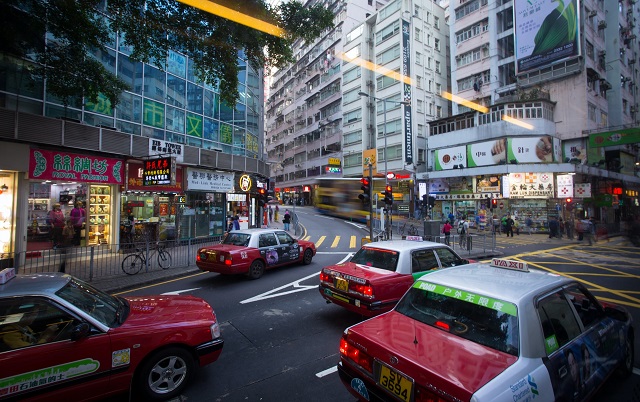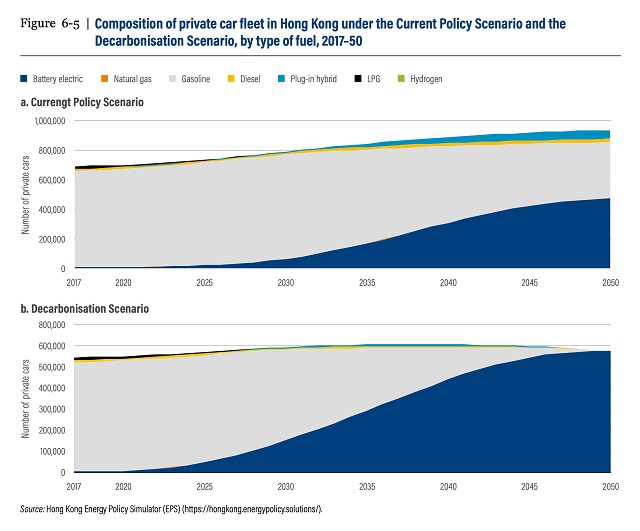
In densely urbanized Hong Kong, transport is the second largest source of greenhouse gas emissions, at 18%. Vehicle traffic is also a major source of toxic air pollutants like NOx, volatile organic compounds and carbon monoxide, accounting for 18%, 21% and 50% of total emissions in 2018, respectively, and a key contributor to public health risks. As a result, Hong Kong moved in March to prohibit new registration of fossil-fueled private cars by 2035 or earlier.
Banning new sales of internal combustion engine vehicles, along with rapid electrification and cleaning the grid, will be key to reducing emissions and forging a healthier, safer transport system.
Here are three takeaways from Hong Kong’s fossil fuel vehicle ban.
Ambitious, But Could Be Even Stronger
Hong Kong’s announcement follows other countries and regions that have announced target years for banning the sale of fossil fuel vehicles, including Norway (2025), UK (2030) and Hainan province in China (2030). However, the scope and ambition of Hong Kong’s policy will need enhancement to reach the government’s goal of achieving carbon neutrality by 2050. According to a WRI China study of Hong Kong’s transport decarbonization pathways, transport emissions could drop by 31% if internal combustion engine vehicles are off the roads by 2035-2040 – but only if all internal combustion vehicles are off the roads, not just private cars.
First, commercial vehicles need a clearer timeline. In Hong Kong, private cars represent 27% of road transport-related CO2 emissions, but buses (13%), taxis (18%) and freight vehicles (42%) also make up very significant portions. The city’s electric vehicle (EV) roadmap mentions electrification pilots for large and hard-to-abate emitters like buses and commercial fleets, but more stringent targets and timelines are needed.
Second, the timeline itself could be more ambitious, and Hong Kong has the capability to make it so. Similar to Norway, it doesn’t have local vehicle manufacturing bases, so potential local job losses from transitioning to EV manufacturing isn’t a major concern. Also, the city’s existing strict travel demand management policies could make it easier for it to rapidly reach cost parity between fossil fuel and electric vehicles.
To disincentivize private car ownership of all types, Hong Kong has implemented a Vehicle First Registration Tax, an annual vehicle license fee, parking space costs and parking fees. Since EV owners receive a preferential tax rebate and fee discount, these policies have worked primarily to make fossil fuel vehicles cost-prohibitive and incentivize EVs. If Hong Kong can strengthen these policies, it can quickly ramp up ambition for EVs and be in the position to ban fossil fuel cars earlier.
We’re Still on Track for More Cars
Bolstering the longstanding travel demand management measures that have already helped shift many journeys to low-carbon modes and promote EVs is critical not only for ramping up Hong Kong’s timeline for phasing out fossil fuel vehicles, but for ensuring that this phase-out is effective at all.
Hong Kong has one of the best public transport systems in the world. Data from 2016 shows it accounted for 90% of all trips in the city. Car ownership levels are also low, with 76 private vehicles per 1,000 people, compared to the United States’ over 700 vehicles per 1,000. But private cars in Hong Kong are still projected to increase from about 600,000 to 840,000 in 2050.
Such an increase could make the road to a complete fossil fuel ban longer and more expensive than is necessary: more private cars, even EVs, potentially means greater public resistance to a policy that targets private car ownership, as well as more money for subsidies, tax rebates and development of the charging network. To avoid this, Hong Kong can do more to disincentivize vehicle ownership, such as increasing the vehicle registration tax, to encourage even more residents to choose public transport and low-carbon mobility over a private car. Our research shows that under transport demand management policies like increased roadway pricing, vehicle ownership costs, parking fees, as well as improved public transit systems, the size of the private car fleet could be reduced by 21% to 660,000 in 2050.

For the private cars that remain, continuing to incentivize EV sales will be essential. By increasing the cost of owning an internal combustion engine vehicle while reducing the cost of an electric one, Hong Kong has helped EVs reach cost parity and facilitated market adoption. EV owners enjoy the First Registration Tax rebate up to HK$287,500 (USD $37,076) for switching to electric vehicles. And the Vehicle First Registration Tax for newly purchased fossil fuel vehicles was recently raised by 15%, and annual license fees for existing private fossil fuel vehicles by 30%. But these rates hadn’t been changed for more than a decade. To continue discouraging fossil fuel vehicle ownership, these rates must be increased regularly.
The city can also use the revenue from these fees, taxes and duties in a more targeted way to promote green transport. For example, it can help replenish public funds like the Green Tech Fund and the New Energy Transport Fund to provide financial support for the adoption of electric vehicles, as well as help fund public transport.
A Decarbonized Power System Is Essential
Establishing a clean electric grid is fundamental to the success of Hong Kong’s vehicle electrification efforts. Currently, around 75% of electricity in the region is sourced from fossil fuels – 50% from natural gas and 25% from coal. The mix has shifted towards natural gas in recent years but replacing coal with gas reduces emissions by only about 50%. Although the government plans to continue to phase down the use of coal by 2030 while increasing the share of natural gas and clean electricity, it is still far from decarbonization of the power system.
Hong Kong should take this opportunity to transition away from fossil fuels and diversify its energy mix. Hong Kong’s power system has its unique characteristics. For example, the potential of domestic renewable energy resources is limited, and a quarter of the region’s power is imported from a single nuclear plant on the mainland. Therefore, reaching zero emission power will require a set of complementary policies, including reinforcing local renewable energy incentives, exploring the possibility of importing more nuclear and renewable energy power from mainland China, deploying carbon capture and storage technology for natural gas, and preparing and exploring power generation from clean hydrogen.
As Hong Kong moves forward with its fossil fuel vehicle ban, WRI is working with local think tank Civic Exchange to enhance the city’s ambition. By strengthening its travel demand management policies, Hong Kong could provide a valuable example to other regions and cities of what a comprehensive transport decarbonization effort can look like.
Lulu Xue is a Research Associate for Sustainable Transport at WRI China Ross Center for Sustainable Cities.
Xiaoqian Jiang is a Research Associate for Climate at WRI China.






